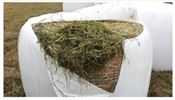Four Steps To Producing Quality Baleage
MOUNTAIN GROVE, MO.
The use of baleage for forage preservation has gained considerable popularity in recent years according to Ted Probert, a dairy specialist with University of Missouri Extension.
“Wet storage of forages in the form of baleage offers several benefits to growers. First, baleage reduces the time needed between cutting and baling,” said Probert. “This allows harvest to occur when it might not be possible to get hay fully cured during cool, wet weather.”
Second, the ability to harvest with fewer concerns about weather allows for harvesting forage crops at an ideal growth stage. This leads to a third advantage, the ability to keep forage harvest on schedule, resulting in higher quality feed for livestock.
“In the end, and with all things considered, baleage systems can result in higher annual yields of nutritionally superior quality feed,” said Probert. “Achievement of this goal depends on paying attention to the details known to be associated with successful baleage harvest and storage.”
STEPS TO SUCCESS
The first consideration for producing high-quality feed through baleage is the timing of harvest. However, it does cost more to produce baleage than hay.
“One of the best means of recouping this added cost is through increased nutritional value of the feed produced. This means harvesting at the correct stage of growth,” said Probert.
For grass crops (small grains, annual grasses, perennial grasses) optimum quality is achieved by cutting in the boot to first flag leaf stage. Alfalfa should be cut at late bud to early bloom.
“It is important to remember that feed quality in forage crops will diminish rapidly when cutting is postponed beyond the optimum harvest stage,” said Probert.
The second step to quality baleage is to harvest properly. The crop should be cut and wilted as quickly as possible to the proper moisture level (50-60 percent) for ensiling in bales.
“Forage will dry more rapidly and more evenly when cut and laid in a wide, uniform swath. Rapid drying will stop plant respiration more quickly and result in a significant improvement in crude protein and TDN content of the resulting feed,” said Probert.
The forage should be wrapped into tight, dense bales to remove as much oxygen as possible. Feed baled too wet is likely to undergo clostridial fermentation, yielding rancid and unpalatable feed. Baling too dry can result in moldy feed with lowered nutrient content and animal acceptance.
Step three is to wrap the bales correctly. Bales should be wrapped as quickly as possible, ideally within two hours of baling. Under no circumstances should bales be left unwrapped longer than 12 hours.
“A long delay from baling to wrapping will lead to overexposure of the forage to oxygen and overheat the bales. Overheating causes damage to ensiled feed by reducing its digestibility. Additionally, heat can lead to caramelization and a reduction in protein availability. Another consideration with wrapping is to use adequate plastic,” said Probert.
The suitable elimination of oxygen requires a minimum of four layers of plastic. Six layers can lead to a measurable reduction in mold growth and improvements in feed quality. If the forage is baled toward the drier end of the ideal range, this is particularly true.
A final step to successful baleage production is to store bales in a suitable manner and to avoid the tendency to forget about them while in storage.
“The greatest success occurs when bales are stored on a well-drained site that is free of any material that might puncture the plastic wrap,” said Probert. “It is also best to keep vegetation down next to the bales to discourage the presence of varmints. Anything that claws, bites, or otherwise punctures the plastic sets your feed up for spoilage.”
Damage can occur from above with birds or other animals that crawl on the bales. It can also occur from below from the chewing and burrowing of rodents.
Inspect bales periodically and patch any holes that are found in the plastic. ∆

The production of high quality, properly preserved forages
should be the goal of an effective baleage system.
Photo credit: MU Extension